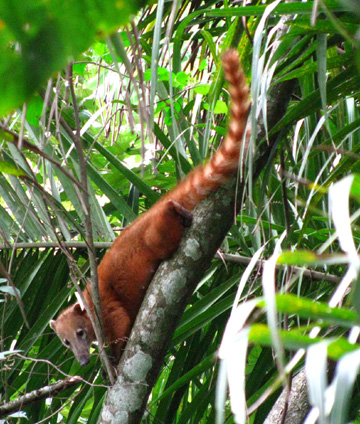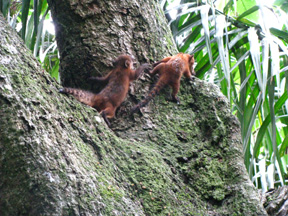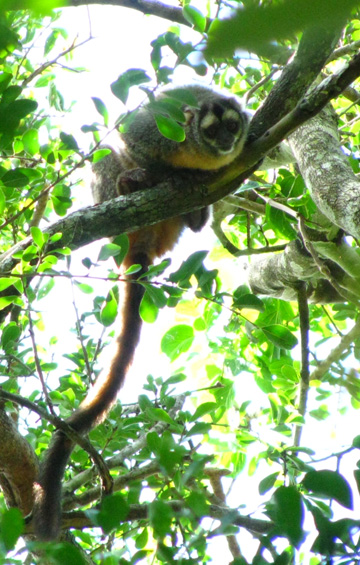Steve and I take shifts so that the nest is under observation for most of the day--the female is incubating and the male makes frequent visits to feed her, so all seems well. On our way through the jungle, walking to and from the nest, we have been lucky enough to observe all sorts of amazing wildlife.
January 23rd
It has been raining on and off with bursts of torrential downpour interspersed with an enduring drizzle. The water is already approaching disconcertingly close to our tent, inspiring us to put up an overhead tarp and dig canals to drain the pools that are forming at the back corners of the tent.
Yesterday evening I watched the nest from 5 to 7 p.m., the last hour of which I was worried by the long absence of the female. She seems to be extraordinarily sensitive and is frightened off her eggs by any sudden noise. She seems to particularly hate sneezes.


January 24th
Sitting in the open and derelict escondite (blind) here at Encanta where we haven't been able to improve the temporary blind (built before they knew that the nest was active) for fear of disturbing Señora Barba Azul, who is extremely sensitive to disruption. The tiger herons are mooing repetitively beyond the nest box, sounding to the inexperienced ear like a jaguar in heat (according to the locals that is-I have not personally heard the calls of a jaguar in heat).
When I arrive, all is still and silent in the nest box and I assume that mom is in there, keeping her eggs warm in the cool, damp morning air. Frogs are chorusing from the flooded pampas and the Thrush-like Wren is making its strange sci-fi shooting noises, which everyone says sounds like the space guns in star wars. This morning, when I put on my rubber boots to get out of the tent, I felt something at the bottom, which luckily moved to the side as I stood up. It wriggled a few times and then, as I stood there, out jumped a little frog and with one hop was back in the water that is now only 2 feet from the tent vestibule, and away it swam. I laughed and said that I supposed that too-big boots served some purpose after all: more room for the frogs to jump out, rather than getting squished. Later, as I was sitting in the outhouse, I felt something else in my boot and I reached in a pulled out a toad-also quite alive. Not surprising, the boot that the frogs and toads prefer is the one with a leak that is always wet inside.
I am very happy to report that all is well in Parabalandía (Macawland). The female is inside her box and only left for 5 minutes since I arrived at 7. I am anxious to climb again and find out if the chicks have hatched, but these days it seems too risky to disturb her.
On the 22nd, on my way back from the evening nest watch, I was amazed and thrilled to see a troop of flying monkeys. Of course they were not quite like the evil, flying monkeys in the Wizard of Oz (luckily) but they jumped from tree to tree just like flying squirrels, with amazing distance and agility, flying through the air with all 4 limbs extended for distances as great as 10 meters. They were extremely quick, agile little creatures, hitting their destination branch and immediately scurrying up the tree, stopping in the high branches to peer down at me briefly: round little faces with big, round, black eyes and striking, white markings above the eyes, giving them their Spanish name: Mono Cuatro-ojos (Four-eyed Monkey). They have dark, soft brown fur on their backs and tails contrasting with rufus bellies that fade to a yellow-white color on their sides. Their tails are about twice the length of their bodies and may or may not have be prehensile (I did not see it used as such).
The group consisted of 4-6 individuals, which made funny, birdlike blipping noises as they moved through the trees. Are these the night-monkeys I have wanted to see for so long? Their presence at dusk and the appearance of their big, round, black eyes make me suspect that I did indeed see a troop of nocturnal flying monkeys! Aside from monkeys, there is a baby caiman living next to my tent, plenty of frogs, two foxes and a raccoon that come around at night and giant black and yellow anacondas and false water-pythons that steal half-grown ducklings. The snakes I have not yet seen.

Back at the house, I am sharing mate with Lucy and Lurdes and watching as they make a crunchy bread called bizcocho: equal parts flour and lard, eggs, yeast, water, salt. Ten-year-old Rolando just finished plucking all the tail feathers out of a young chicken. When I asked why, he and Lurdes (his mom) explained that you have to puck the tail so that its body will grow bigger. The tail stunts its growth otherwise, they claim, and it will grow to be a tiny, skinny chicken with no meat on its bones, and a long, useless tail.
"But the tail will just grow back," I said.
"And we'll pluck it again," said Lurdes. They laughed at my raised eyebrows and laughed even harder when I said I didn't believe it was true. "It's true," they assured me. “Haven’t you seen those tiny little chickens with huge tails? The tail doesn't let the meat grow.” I then jokingly suggested, perhaps a bit unkindly, that the reason Yusara was fat was because she has short hair. Lurdes, Rolando and Lucy laughed uproariously at this comment. "Yes, it's true!" said Lucy. “If you let her hair grow long she will get thin, like me and Sarah." Yusara was good-natured about the joke, since being chubby in Bolivia isn't seen as something to be terribly ashamed of the way it often is here in the U.S.
































